HOW TO: Upload an ISO CD-ROM/DVD-ROM image to a VMware datastore for use with VMware vSphere Hypervisor 5.1 (ESXi 5.1) using the vSphere Client, and checking its MD5 checksum signature is correct.
EE Fellow, MVE, Expert of the Year 2021,2017-11, Scribe 2016-2012, Author of the Year 2018-6,2013-2012 VMware vExpert Pro, vExpert 2022-2011
Published:
Browse All Articles > HOW TO: Upload an ISO CD-ROM/DVD-ROM image to a VMware datastore for use with VMware vSphere Hypervisor 5.1 (ESXi 5.1) using t…
In my previous 24 VMware Articles, most featured Intermediate VMware Topics. My next series of articles will concentrate on topics for the VMware Novice; this is the fourth article in this series.
If you would like to read the other articles in this series, they are listed here for your convenience.
HOW TO: Install and Configure VMware vSphere Hypervisor 5.1 (ESXi 5.1)
HOW TO: Connect to the VMware vSphere Hypervisor 5.1 (ESXi 5.1) using the vSphere Client
HOW TO: Create an ISO CD-ROM/DVD-ROM image (*.iso), and MD5 checksum signature, for use with VMware vSphere Hypervisor 5.1 (ESXi 5.1)
In this series of basic VMware articles for the Novice, I'll be showing you the basic VMware skills required to install, configure and deploy virtual machines using VMware's FREE VMware vSphere Hypervisor (ESXi).
In this article we will show you HOW TO: Upload an ISO CD-ROM/DVD-ROM image to a VMware datastore for use with VMware vSphere Hypervisor 5.1 (ESXi 5.1) using the vSphere Client, and checking its MD5 checksum signature is correct. There are other third party tools, that can be used to upload ISO image files, these include:-
![vSphere Client Connected to ESXi 5.1 Server]() Once connected to the "default hypervisor home page", click the Inventory icon, to see the server's Inventory.
Once connected to the "default hypervisor home page", click the Inventory icon, to see the server's Inventory.
![Inventory]() Right Click on the datastore. In this example the datastore name is datastore1. This is the default name given to the datastore on installation, it can be changed. Please refer to Step 4 Conducting a simple task using the VMware vSphere Client in my EE article HOW TO: Connect to the VMware vSphere Hypervisor 5.1 (ESXi 5.1) using the vSphere Client
Right Click on the datastore. In this example the datastore name is datastore1. This is the default name given to the datastore on installation, it can be changed. Please refer to Step 4 Conducting a simple task using the VMware vSphere Client in my EE article HOW TO: Connect to the VMware vSphere Hypervisor 5.1 (ESXi 5.1) using the vSphere Client
![Right Click and select Browse Datastore]() Right Click the datastore name 'datastore1' and select Browse Datastore.
Right Click the datastore name 'datastore1' and select Browse Datastore.
![Datastore Browser window]() The Datastore Browser window will be opened, and you can browse the files and folders, that are located on the datastore. If no virtual machines or files are present, this will be empty. To organise your ISO image files, we would recommend you create a folder called isos. Either select the 'Create A New Folder' icon, on the ribbon bar, or right-click in the right-hand empty panel, and select New Folder.
The Datastore Browser window will be opened, and you can browse the files and folders, that are located on the datastore. If no virtual machines or files are present, this will be empty. To organise your ISO image files, we would recommend you create a folder called isos. Either select the 'Create A New Folder' icon, on the ribbon bar, or right-click in the right-hand empty panel, and select New Folder.
![Create Folder in datastore]() Enter folder name - isos, and Click OK
Enter folder name - isos, and Click OK
![Enter Foldername - isos]() The isos folder will be shown in the datastore
The isos folder will be shown in the datastore
![datastore1 with isos folder]() Select and Double-Click the isos folder to change folders.
Select and Double-Click the isos folder to change folders.
![isos folder]()
![Upload files to this datastore]() Select the 'Upload files to this datastore' icon on the ribbon bar.
Select the 'Upload files to this datastore' icon on the ribbon bar.
![Select Upload Files]() Select Upload File...
Select Upload File...
![Browse to location of the stored iso image file on your computers hard disk]() Browse to location of the stored iso image file on your computers hard disk, in my example, we have stored the iso image file, in c:\isos, from our previous EE Article, the filename is Ubuntu 12.10 amd.iso. Click OK to continue and upload the file.
Browse to location of the stored iso image file on your computers hard disk, in my example, we have stored the iso image file, in c:\isos, from our previous EE Article, the filename is Ubuntu 12.10 amd.iso. Click OK to continue and upload the file.
![Select Yes to the Upload/Downloading Operation Warning]() Select Yes to the Upload/Downloading Operation Warning.
Select Yes to the Upload/Downloading Operation Warning.
![Uploading...]() The ISO image file, e.g. Ubuntu 12.10 amd.iso will be upload to datastore1 in the folder isos. This can take several minutes depending upon size and speed of connection to the VMware vSphere Hypervisor 5.1 (ESXi 5.1) host server.
The ISO image file, e.g. Ubuntu 12.10 amd.iso will be upload to datastore1 in the folder isos. This can take several minutes depending upon size and speed of connection to the VMware vSphere Hypervisor 5.1 (ESXi 5.1) host server.
![datastore1 with iso image]() datastore1 with the ISO image uploaded and stored in the folder isos. Click the X in the top right hand corner to Close the Datastore Browser.
datastore1 with the ISO image uploaded and stored in the folder isos. Click the X in the top right hand corner to Close the Datastore Browser.
To Enable SSH on your VMware vSphere Hypervisor 5.1 (ESXi 5.1) host server, please see my EE Article HOW TO: Enable SSH Remote Access to a VMware vSphere Hypervisor 5.1 (ESXi 5.1)
Connect to the VMware Hypervisor ESXi server via SSH. Using PuTTY a free telnet and SSH client or another SSH client Login and Connect to the VMware Hypervisor ESXi server, using IP address or hostname of the VMware Hypervisor ESXi server, using root username and password credentials. This can also be performed if you have access to the console.
![PuTTY SSH terminal session]()
![logged in as root to ssh terminal session]() You will need to change folder or directories to the location of the iso image file. The VMware VMFS datastores are mapped here /vmfs/volumes. Use the following command to change to the datastore1 datastore and isos folder.
You will need to change folder or directories to the location of the iso image file. The VMware VMFS datastores are mapped here /vmfs/volumes. Use the following command to change to the datastore1 datastore and isos folder.
cd /vmfs/volume/<datastore name>/<folder name>
![change folders]() example :- cd /vmfs/volumes/datastore1/i
example :- cd /vmfs/volumes/datastore1/isos
type cd /vmfs/volumes/datastore1/isos in the SSH session window.
![md5sum]() When you have successfully changed folders to the location of the isos image file which has been uploaded, use the following command to check the MD5 checksum signature.
When you have successfully changed folders to the location of the isos image file which has been uploaded, use the following command to check the MD5 checksum signature.
md5sum <filename>
example md5sum Ubuntu 12.10 amd.iso
![MD5 Checksum Signature]() type md5sum Ubuntu 12.10 amd.iso in the SSH session window. After several minutes, and the time taken, depends on the size of the ISO image file, and speed of host processor and storage, a MD5 checksum signature will be displayed. The number displayed next to the filename - 7ad57cadae955bd04019389d4b
type md5sum Ubuntu 12.10 amd.iso in the SSH session window. After several minutes, and the time taken, depends on the size of the ISO image file, and speed of host processor and storage, a MD5 checksum signature will be displayed. The number displayed next to the filename - 7ad57cadae955bd04019389d4b9c1dcb - is the MD5 checksum signature. Compare this number with the original number computed before the ISO image file was uploaded, if they match, the transfer was successful. If they do not match, repeat Step 2 above.
Congratulations, you have successfully uploaded an ISO CD-ROM/DVD-ROM image to a VMware datastore for use with VMware vSphere Hypervisor 5.1 (ESXi 5.1) using the vSphere Client, and checked its MD5 checksum signature is correct.
***************************************************************************
Thank you for reading my article, please leave valuable feedback. If you liked my VMware article and would like to see more Articles from me, please click the Yes button near the: Was this article helpful? at the bottom of this article just below and to the right of this information. Thank You. Do not forget if you have a question about this article or another VMware, Virtualisation, Windows Server 2012 question, why not post a Question for me and the other Experts Exchange Experts in the VMware, Virtualisation, Windows 2008, Windows 2012 Zones. I look forward to hearing from you. - Andy :- twitter @einsteinagogo
****************************************************************************
If you would like to read the other articles in this series, they are listed here for your convenience.
HOW TO: Install and Configure VMware vSphere Hypervisor 5.1 (ESXi 5.1)
HOW TO: Connect to the VMware vSphere Hypervisor 5.1 (ESXi 5.1) using the vSphere Client
HOW TO: Create an ISO CD-ROM/DVD-ROM image (*.iso), and MD5 checksum signature, for use with VMware vSphere Hypervisor 5.1 (ESXi 5.1)
In this series of basic VMware articles for the Novice, I'll be showing you the basic VMware skills required to install, configure and deploy virtual machines using VMware's FREE VMware vSphere Hypervisor (ESXi).
In this article we will show you HOW TO: Upload an ISO CD-ROM/DVD-ROM image to a VMware datastore for use with VMware vSphere Hypervisor 5.1 (ESXi 5.1) using the vSphere Client, and checking its MD5 checksum signature is correct. There are other third party tools, that can be used to upload ISO image files, these include:-
Veeam FastSCP which is now part of Veeam Backup Free Edition for VMware and Hyper-V - http://www.veeam.com/virtual-machine-backup-solution-free.html?ad=vmware-esxi-fastscp-go-to.html
The above applications, require additional installation and configuration, in this article we will use the VMware vSphere Client.
1. Connect to the VMware vSphere Hypervisor 5.1 (ESXi 5.1) or vSphere vCenter Server using the vSphere Client
Please refer to my EE article on HOW TO: Connect to the VMware vSphere Hypervisor 5.1 (ESXi 5.1) using the vSphere Client Once connected to the "default hypervisor home page", click the Inventory icon, to see the server's Inventory.
Once connected to the "default hypervisor home page", click the Inventory icon, to see the server's Inventory.
 Right Click on the datastore. In this example the datastore name is datastore1. This is the default name given to the datastore on installation, it can be changed. Please refer to Step 4 Conducting a simple task using the VMware vSphere Client in my EE article HOW TO: Connect to the VMware vSphere Hypervisor 5.1 (ESXi 5.1) using the vSphere Client
Right Click on the datastore. In this example the datastore name is datastore1. This is the default name given to the datastore on installation, it can be changed. Please refer to Step 4 Conducting a simple task using the VMware vSphere Client in my EE article HOW TO: Connect to the VMware vSphere Hypervisor 5.1 (ESXi 5.1) using the vSphere Client
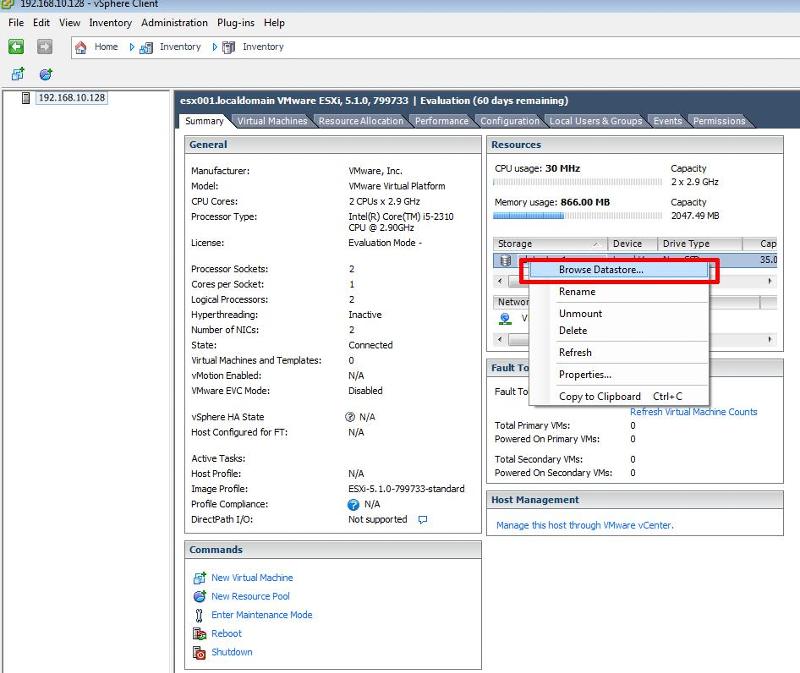 Right Click the datastore name 'datastore1' and select Browse Datastore.
Right Click the datastore name 'datastore1' and select Browse Datastore.
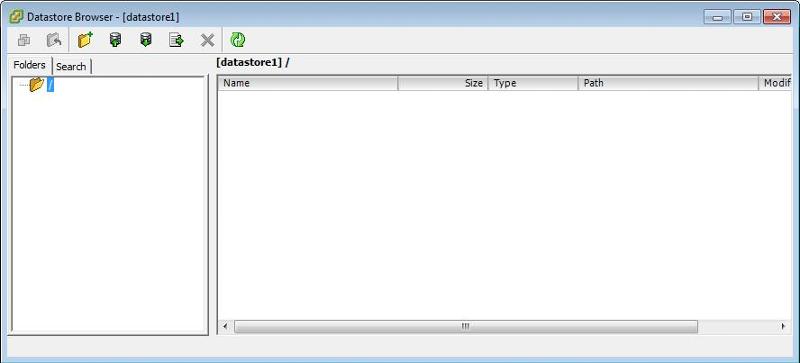 The Datastore Browser window will be opened, and you can browse the files and folders, that are located on the datastore. If no virtual machines or files are present, this will be empty. To organise your ISO image files, we would recommend you create a folder called isos. Either select the 'Create A New Folder' icon, on the ribbon bar, or right-click in the right-hand empty panel, and select New Folder.
The Datastore Browser window will be opened, and you can browse the files and folders, that are located on the datastore. If no virtual machines or files are present, this will be empty. To organise your ISO image files, we would recommend you create a folder called isos. Either select the 'Create A New Folder' icon, on the ribbon bar, or right-click in the right-hand empty panel, and select New Folder.
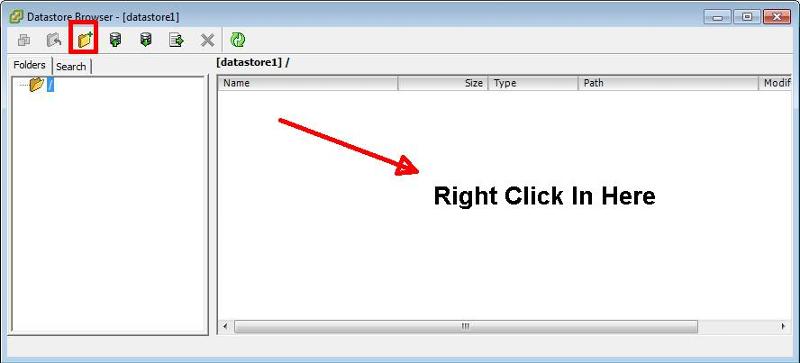 Enter folder name - isos, and Click OK
Enter folder name - isos, and Click OK
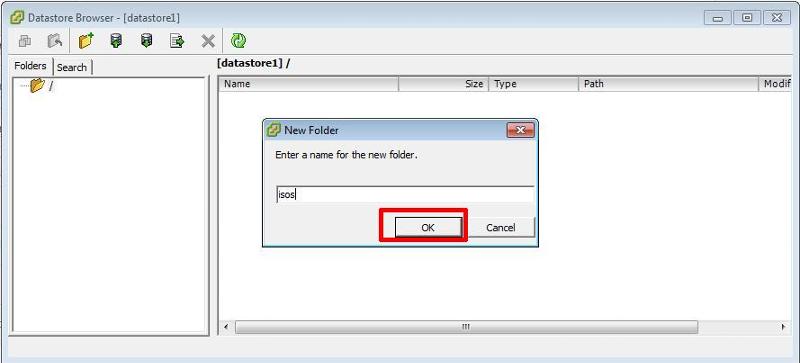 The isos folder will be shown in the datastore
The isos folder will be shown in the datastore
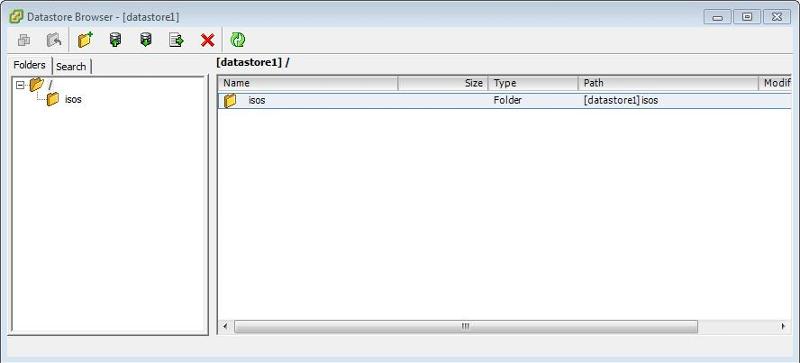 Select and Double-Click the isos folder to change folders.
Select and Double-Click the isos folder to change folders.
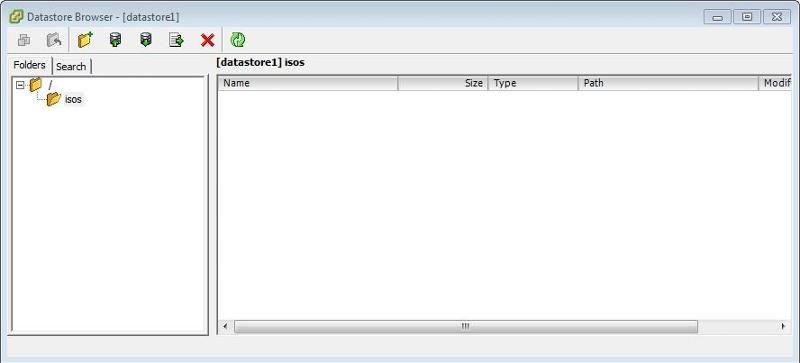
2. Uploading the ISO CD-ROM/DVD-ROM image to the datastore 'datastore1'
Please refer to my EE Article HOW TO: Create an ISO CD-ROM/DVD-ROM image (*.iso), and MD5 checksum signature, for use with VMware vSphere Hypervisor 5.1 (ESXi 5.1)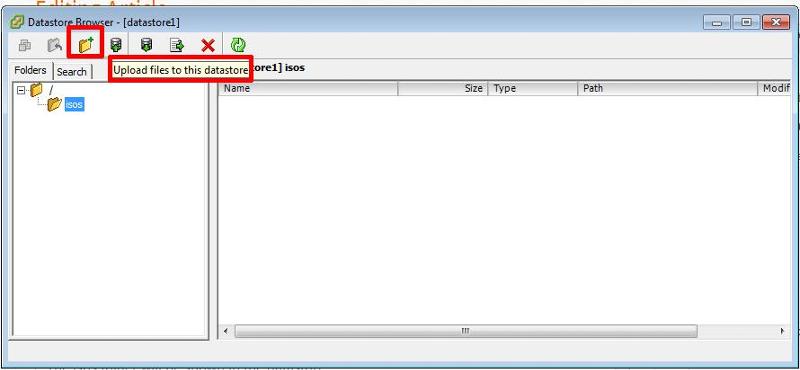 Select the 'Upload files to this datastore' icon on the ribbon bar.
Select the 'Upload files to this datastore' icon on the ribbon bar.
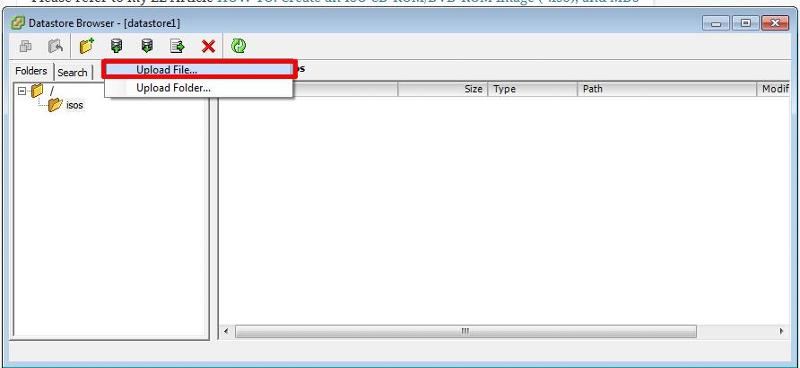 Select Upload File...
Select Upload File...
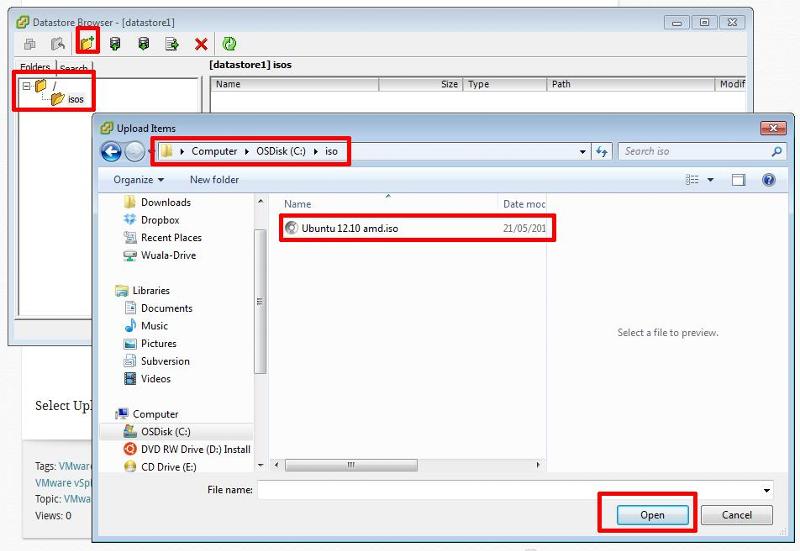 Browse to location of the stored iso image file on your computers hard disk, in my example, we have stored the iso image file, in c:\isos, from our previous EE Article, the filename is Ubuntu 12.10 amd.iso. Click OK to continue and upload the file.
Browse to location of the stored iso image file on your computers hard disk, in my example, we have stored the iso image file, in c:\isos, from our previous EE Article, the filename is Ubuntu 12.10 amd.iso. Click OK to continue and upload the file.
 Select Yes to the Upload/Downloading Operation Warning.
Select Yes to the Upload/Downloading Operation Warning.
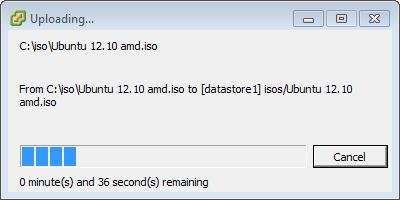 The ISO image file, e.g. Ubuntu 12.10 amd.iso will be upload to datastore1 in the folder isos. This can take several minutes depending upon size and speed of connection to the VMware vSphere Hypervisor 5.1 (ESXi 5.1) host server.
The ISO image file, e.g. Ubuntu 12.10 amd.iso will be upload to datastore1 in the folder isos. This can take several minutes depending upon size and speed of connection to the VMware vSphere Hypervisor 5.1 (ESXi 5.1) host server.
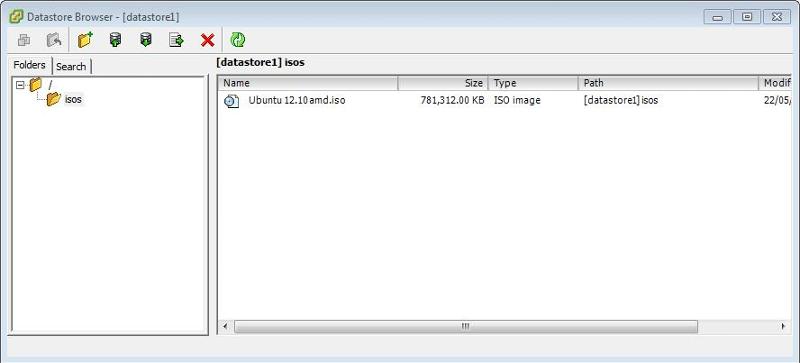 datastore1 with the ISO image uploaded and stored in the folder isos. Click the X in the top right hand corner to Close the Datastore Browser.
datastore1 with the ISO image uploaded and stored in the folder isos. Click the X in the top right hand corner to Close the Datastore Browser.
3. Confirming the upload of the ISO image file has been transferred successfully using the MD5 checksum signature
To complete the following step SSH must be enabled and running on your VMware vSphere Hypervisor 5.1 (ESXi 5.1) host server, if SSH is not running you will receive a connection refused message.To Enable SSH on your VMware vSphere Hypervisor 5.1 (ESXi 5.1) host server, please see my EE Article HOW TO: Enable SSH Remote Access to a VMware vSphere Hypervisor 5.1 (ESXi 5.1)
Connect to the VMware Hypervisor ESXi server via SSH. Using PuTTY a free telnet and SSH client or another SSH client Login and Connect to the VMware Hypervisor ESXi server, using IP address or hostname of the VMware Hypervisor ESXi server, using root username and password credentials. This can also be performed if you have access to the console.

 You will need to change folder or directories to the location of the iso image file. The VMware VMFS datastores are mapped here /vmfs/volumes. Use the following command to change to the datastore1 datastore and isos folder.
You will need to change folder or directories to the location of the iso image file. The VMware VMFS datastores are mapped here /vmfs/volumes. Use the following command to change to the datastore1 datastore and isos folder.
cd /vmfs/volume/<datastore name>/<folder name>
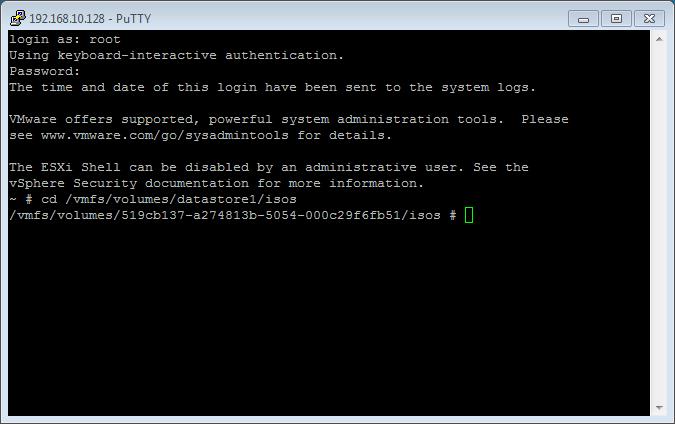 example :- cd /vmfs/volumes/datastore1/i
example :- cd /vmfs/volumes/datastore1/itype cd /vmfs/volumes/datastore1/i
 When you have successfully changed folders to the location of the isos image file which has been uploaded, use the following command to check the MD5 checksum signature.
When you have successfully changed folders to the location of the isos image file which has been uploaded, use the following command to check the MD5 checksum signature.
md5sum <filename>
example md5sum Ubuntu 12.10 amd.iso
 type md5sum Ubuntu 12.10 amd.iso in the SSH session window. After several minutes, and the time taken, depends on the size of the ISO image file, and speed of host processor and storage, a MD5 checksum signature will be displayed. The number displayed next to the filename - 7ad57cadae955bd04019389d4b
type md5sum Ubuntu 12.10 amd.iso in the SSH session window. After several minutes, and the time taken, depends on the size of the ISO image file, and speed of host processor and storage, a MD5 checksum signature will be displayed. The number displayed next to the filename - 7ad57cadae955bd04019389d4bCongratulations, you have successfully uploaded an ISO CD-ROM/DVD-ROM image to a VMware datastore for use with VMware vSphere Hypervisor 5.1 (ESXi 5.1) using the vSphere Client, and checked its MD5 checksum signature is correct.
**************************
Thank you for reading my article, please leave valuable feedback. If you liked my VMware article and would like to see more Articles from me, please click the Yes button near the: Was this article helpful? at the bottom of this article just below and to the right of this information. Thank You. Do not forget if you have a question about this article or another VMware, Virtualisation, Windows Server 2012 question, why not post a Question for me and the other Experts Exchange Experts in the VMware, Virtualisation, Windows 2008, Windows 2012 Zones. I look forward to hearing from you. - Andy :- twitter @einsteinagogo
**************************
Have a question about something in this article? You can receive help directly from the article author. Sign up for a free trial to get started.


Comments (5)
Commented:
Best regards.
Author
Commented:Commented:
Author
Commented:Andy
Commented: